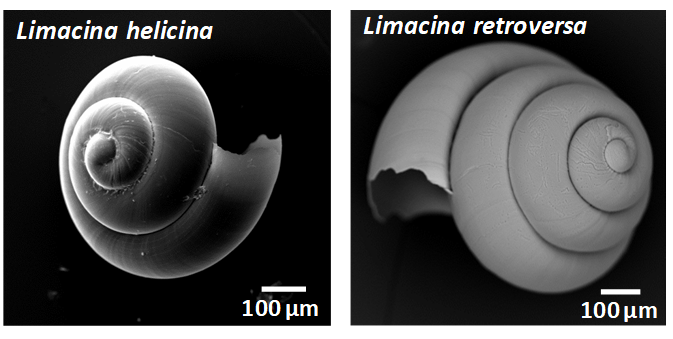Pelagic gastropods (sea snails) are molluscs. This group comprises gastropods which spend their entire life cycle as planktonic organisms (mainly pteropods) as well as the pelagic larvae of otherwise benthic gastropod species. These organisms play an important part in the pelagic food web and in biogeochemical cycles of the ocean.
Pelagic gastropod specimens collected monthly between 2011 and 2013 from the Scottish Coastal Observatory (SCObs) monitoring site at Stonehaven were examined using scanning electron microscopy (SEM) and the relationship with ocean acidification (pH and aragonite saturation, Ωarg) investigated (León et al., 2019). Two species of pteropods (Limacina retroversa and Limacina helicina) (Figure 1) and the larvae of several benthic gastropod species were identified from collected samples.

Figure 1: Scanning Electron Microscopy images of the pelagic gastropods Limacina helicina and Limacina retroversa.
The SCObs site at Stonehaven remained supersaturated with respect to aragonite and calcite (Ωarg >1) throughout the duration of the study, implying that aragonite concentration is not a limiting factor for the formation of the shells of these gastropods. However, the majority of taxa were found to have evidence of shell dissolution (Figure 2), with the highest proportion of dissolution occurring as the Ωarg decreased towards the winter months. Other field studies, such Peck et al. (2018) in the Greenland Sea also reported shell dissolution under supersaturated conditions.

Figure 2: Evidence of shell dissolution in pelagic gastropod larvae specimen.
The proportion of shell dissolution was highest in the early life stages (larvae) of gastropods. The amount of shell dissolution was not consistent across taxonomic groups implying that the response of marine calcifiers to ocean acidification may differ.
The temporal variability of shell dissolution and carbonate chemistry highlights the requirement for a longer time series of data to further the understanding of the response of calcifying plankton to ocean acidification.
Links and resources
|
, 2019. Relationship between shell integrity of pelagic gastropods and carbonate chemistry parameters at a Scottish Coastal Observatory monitoring site. ICES Journal of Marine Science. Available at: https://academic.oup.com/icesjms/advance-article/doi/10.1093/icesjms/fsz178/5584407. |

